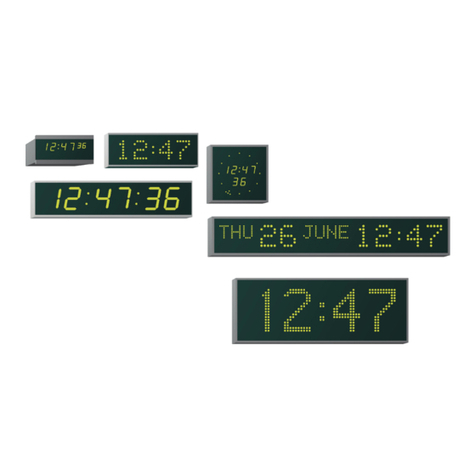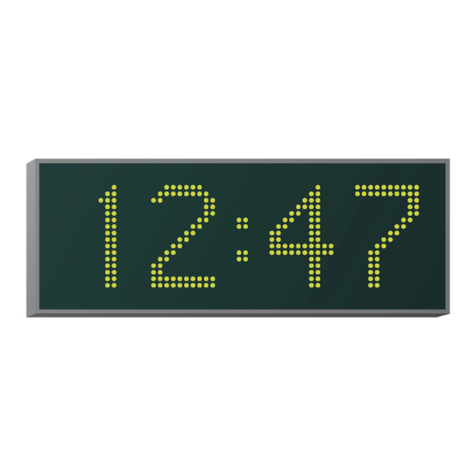Issue 2.0
4850 / 4860 Master Clock
Operating and Installation Instructions
1-1
Package Contents
The product package should contain the following items:
1 4850 / 4860 Master Clock.
2 IEC Mains lead (4850.R and 4860) or AC power adapter
(4850.T). (Either UK, EU, US or AU style depending on
order code)
3 9-pin RS-232 serial cable.
4 This manual.
5 4850 / 4860 software CD-ROM.
6 RJ45 patch lead ( 486xnet only)
For systems supplied with GPS receiver:
6 GPS antenna / receiver module.
7 25 metres of 4 core cable
or systems suppled with MSF or DCF radio receiver.
6 484.02 / 484.06 MSF or 484.03 / 484.07 DCF
radio receiver with 5 metres of cable.
1 - Introduction
The 4850 / 4860 Systems Master Clock provides the time
synchronisation solution for complete systems of equipment,
including computer networks, CCTV security, voice recording,
industrial process control and CCC applications. Available as
standard with MSF, DCF and GPS input synchronisation options,
optionally the 4860 can be supplied to synchronise from an
NTP time source or from IRIG-B time code. This flexibility
allows the 4850 / 4860 to be used as a universal solution for
providing time synchronisation to many different devices.
Features
•Operational
High visibility 6 digit display.
Display and timecode output messages can be
referenced to UTC or ‘Local’ time.
‘Set Once’ local time zone setup, automatically
calculating future time zone changes for local time
zone.
256 Year Calendar, 4 digit year setting. (Range 2000-
2255)
Easy to install, ‘setup and forget’ operation.
• Timing accuracy
Integrated TCXO module standard on 4860 versions.
Unsynchronised: 0.1sec/day @ 0-45ºC (20-25 ºC on
4850)
Locked to MSF or DCF: within 30mS of UTC
Locked to GPS: within 50uS of UTC (100uS on 4850)
• Network Timing Accuracy (4860net only)
Clients typically synchronised within 1-10 milliseconds
of 4860net timebase depending on network delay and
jitter. (NTP)
• RS232 and RS485/422 interface
One, two (4860.S2 versions only) or four (4860.S4
versions only) RS232 and RS485 serial outputs.
71 preset data formats for specific CCTV and
embedded equipment. Output interval programmable
for every second, every minute, 5 minutes, every hour,
every day or on request.
User selection of 1200, 2400, 4800, 9600 or 19200
baud, 7 or 8 data bits and odd, even or no parity on
nonspecific message formats
• Relay
30v dc. @ 500mA rated change-over contacts
0.1 second programmable contact change-over to
occur; every 5 seconds; every minute; every hour; once
per day at a user programmable time; on power
failure; whilst locked to an external time reference and
during an error state.
• w482 interface
Supports up to 50 400A series digital clocks and time
zone displays.
‘Set Once’ time zone setup, automatically calculating
future seasonal time changes for 15 time zones.
The 4860net Master Clock is supplied fitted with a 10Base-T
Ethernet interface to allow it to act as a time server on a TCP/IP
network. The 4860net interface supports the following
protocols:
• NTP and SNTP
Network Time Protocol (NTP) v2, v3 and v4 clients are
supported. (RFC1305 & RFC1119)
Simple Network Time Protocol (SNTP) v3 and v4 clients
are supported. (RFC2030 & RFC1769)
• TIME Protocol
TIME protocol (RFC868) is supported in UDP mode.
Additional outputs present on 4861x and 4850.x.I versions
• IRIG interface
1KHz amplitude modulated 3v p-p, 600Ωtransformer
coupled output.
RS485 level output. (RS485 interface can either be used
for serial or IRIG data)
Output formats: IRIG-B (B123), Afnor NFS 87-500,
NENA 911, IEEE 1344, MIC20
Additional outputs present on 4862x and 4850.x.E versions
• EBU interface
EBU longitudinal timecode (LTC) output, 2000 bps with
25 complete messages every second.
Balanced 600Ωand low impedance (not available on
4850.x.E) outputs.
Additional output interfaces present on 4860x.IMP versions
• Impulse outputs
Dual 24V alternate polarity impulse outputs rated at
200mA per channel.
Each output programmable for one second, half minute
or one minute alternate polarity impulses.
Fully protected output drive circuitry detects power
failure and short circuit line conditions which are
automatically corrected for on fault removal.
Environment
Power supply: 4850.R & 4860 - 110-240V AC 50/60Hz
4850.T - 12v DC via supplied external 110v or
230v AC PSU (specifiy required PSU at time of order)
Power consumption: < 0.4A @ 230V AC
Battery Backup: 4860 >1 Year.
4850 > 50 hours when fully charged.
(The battery backup maintains the internal time count during
periods of mains failure)
Enclosure: 4850.R & 4860 - 1u high 19” rack mount
483mm wide x 185mm deep x 44mm high (19” x 7.3” x 1.75”)
Weight: 2.8Kg
4850.T - Table top case
173mm wide x 178mm deep x 49mm high (6.8” x 7” x 2”)
Weight: 0.5Kg
Operating temperature: 0-50ºC
Relative Humidity: 0% to 90% (non-condensing.)
Altitude: 0 to 3,000m
MTBF: > 50,000 hours





























